
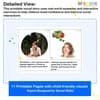
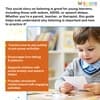
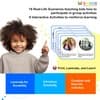
Joining a Group Activity – Social Story for Kids’ Social Confidence
₹80
₹160
50% off
0 (0 ratings)
Grade Levels
Pre-K - Grade 3 (Ages 4-9)
Content Overview
Format: Printable PDF, Total Pages: 11, Features: 16 real-life scenarios, engaging illustrations, 6 interactive activities
Categories
Pages from the Resource
Help children learn how to join group activities with confidence using this social story. With real-life scenarios, friendly illustrations, and step-by-step guidance, kids discover how to ask politely, wait their turn, and become part of a group. Ideal for autism, ADHD, and social-emotional learning.
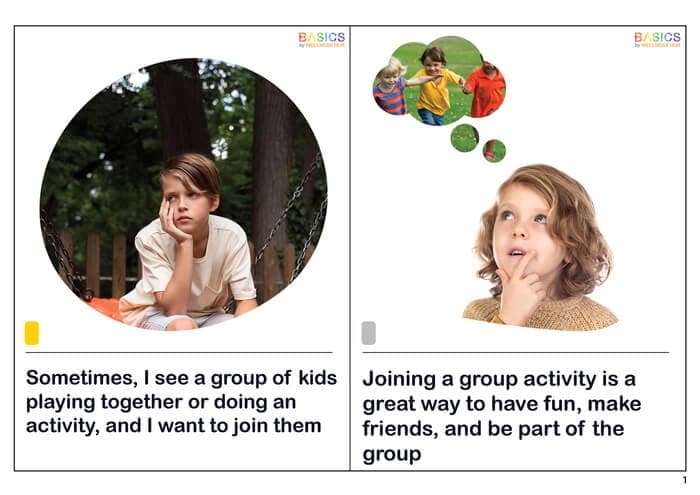
Page 1
Page 2
What Users Say
0
0 ratings
5
0+
4
0+
3
0+
2
0+
1
0+
5 Stars
Product is Good to use.
1 year ago
Varsha Parent
Similar Products

Giving and Receiving Compliments – Social Story for Kids
₹ 80.00
₹ 160.00
50% off
5.0 (52 ratings)
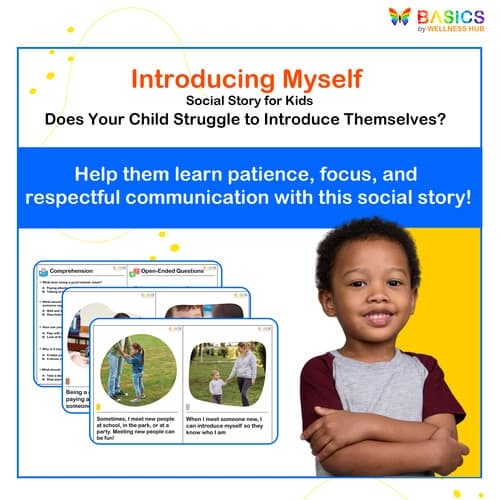
Introducing Myself – Free Social Story for Kids’ Communication Skills
₹ 80.00
₹ 160.00
50% off
4.8 (60 ratings)
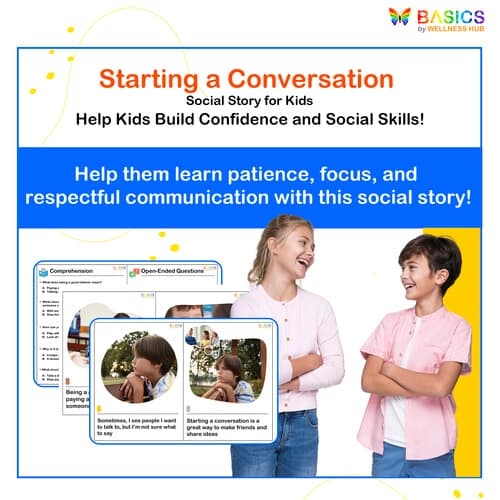
Starting Conversations – Social Story for Kids' Communication Skills
₹ 80.00
₹ 160.00
50% off
5.0 (56 ratings)

Making Friends – Social Story for Building Social Skills
₹ 80.00
₹ 160.00
50% off
4.9 (52 ratings)
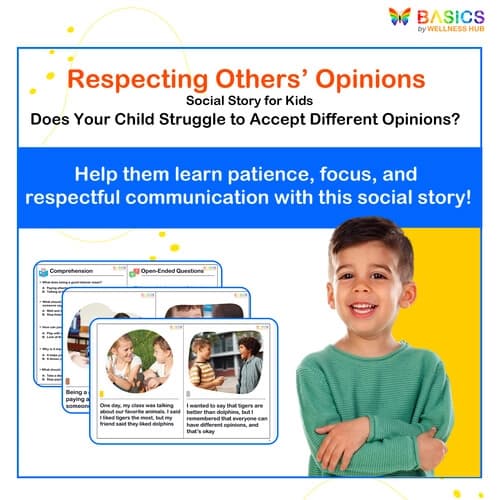
Respecting Others’ Opinions – Free Social Story for Kids
₹ 80.00
₹ 160.00
50% off
4.8 (46 ratings)
About the Product
Introduction
For many children, joining a group activity can be a challenging experience. Whether it's during playtime, in the classroom, or at social gatherings, the process of asking to join a group, waiting for a turn, and understanding group dynamics can often feel overwhelming. Children with autism, ADHD, or other social-emotional challenges might struggle to engage confidently with peers in group settings.
This printable social story is designed to help children learn how to navigate group activities and build the confidence and social skills they need to participate comfortably. By breaking down each step of joining a group activity, the social story provides clear, understandable guidance that children can relate to and apply in real-life situations.
The story uses real-life scenarios, child-friendly language, and engaging illustrations to show children how to appropriately join group activities, ask politely, wait for their turn, and participate in group conversations. This resource is ideal for use at home, in the classroom, or during therapy sessions, offering a structured approach for teaching group participation in an accessible and enjoyable way.
Product Details
- Format: Printable PDF
- Total Pages: 11
- Segments: 16 real-life scenarios showing how to join a group and participate in group activities.
- Features:
✔ First-person perspective storytelling for relatable experiences.
✔ Engaging illustrations that support each segment and clarify key social concepts.
✔ 6 interactive activities to reinforce learning, including role-playing and comprehension exercises.
✔ Child-friendly language that simplifies complex social concepts.
✔ Multiple scenarios including asking to join a game, waiting for a turn, and engaging in group conversations.
This structured approach helps children understand social expectations around joining a group and gives them the tools they need to engage successfully. The activities and scenarios support gradual learning, allowing children to apply their skills in different social settings.
Educational Benefits
This social story is not only a tool for social skills development, but it also supports emotional growth and enhances children’s ability to manage social situations with ease and confidence.
1. Builds Confidence in Social Situations
✔ Encourages children to engage with their peers by teaching them the steps to confidently join a group.
✔ Helps children understand how to ask politely to join a game or activity.
✔ Reinforces the importance of patience and waiting for a turn in group settings, reducing anxiety.
2. Teaches Group Interaction Skills
✔ Provides children with the necessary skills to participate in group play, discussions, and cooperative activities.
✔ Includes exercises that help children learn how to maintain positive body language, make eye contact, and listen actively during group interactions.
✔ Helps children develop empathy by teaching them to recognize social cues and respect others' needs and space.
3. Enhances Emotional Regulation
✔ Teaches children to manage their emotions when joining a group, especially if they feel nervous or excluded.
✔ Helps children understand that waiting for a turn is a natural part of group play, reducing frustration and promoting self-regulation.
4. Supports Special Education Needs
✔ Designed for children with autism, ADHD, and other social-emotional challenges to help them build essential social skills in a structured, safe environment.
✔ Can be used by teachers, therapists, and parents to target specific goals in social-emotional learning (SEL) and communication development.
5. Engaging and Interactive
✔ Includes 6 interactive activities that encourage children to practice what they’ve learned in a fun, hands-on way.
✔ Provides role-playing scenarios and matching activities that allow children to apply group participation skills in real-life contexts.
Instructions for Use
The "Joining a Group Activity" Social Story is easy to incorporate into home, classroom, or therapy settings. To get the most out of this resource, follow these steps:
1. Read the Social Story Aloud
- Start by reading the story with the child.
- Use simple language and point out the illustrations as you read.
- Pause at key moments to ask open-ended questions about the story and how the child might feel in similar situations. For example:
"How would you feel if you were the one waiting to join the game?"
"What’s the best way to ask if you can play with someone?"
2. Use Real-Life Scenarios
- After reading the story, identify real-life moments where the child can practice the social skills they’ve learned (e.g., asking to join a group at the playground or in the classroom).
- Encourage the child to apply the lessons learned in everyday situations and praise their efforts to reinforce positive behavior.
3. Practice with Interactive Activities
- Use the 6 interactive activities provided in the resource.
- These activities include role-playing scenarios, where the child acts out joining a group, matching games to understand group dynamics, and reflection exercises to assess the child’s understanding of key social concepts.
- Reinforce the use of polite requests and patience through comprehension activities and visual aids.
4. Review and Reinforce
- Review the social story regularly to reinforce the skills learned.
- Use visual prompts such as posters or charts in the child’s environment to remind them of the steps for joining a group.
- Celebrate small victories by acknowledging when the child successfully joins a group activity or asks to participate politely.
5. Encourage Ongoing Practice
- Consistently model appropriate social behaviors by joining group activities and showing the child how to interact with others.
- Offer positive reinforcement when the child successfully shares, takes turns, or engages with a group, especially in new or challenging settings.
Activities Using the Resource
The "Joining a Group Activity" Social Story is designed to reinforce social skills through interactive activities that engage children and help them practice the core skills necessary to participate in group activities. Below are the activities that should be used to maximize the educational benefit of this resource.
1. Role-Playing Group Participation
Objective: To practice how to ask to join a group and appropriately participate.
- Materials: No materials needed except for the social story itself.
- How to Play:
- After reading the story, act out scenarios where the child asks to join a group activity (e.g., "Can I play with you?").
- Encourage the child to practice polite phrases such as:
- "Can I join you in the game?"
- "I’d like to play with you. May I take a turn?"
- Guide the child in understanding the importance of waiting for their turn if the group is already playing.
- Discuss how to respectfully ask if the child feels like they’re not being included.
2. Matching Social Scenarios to Responses
Objective: To reinforce the correct behaviors in different social scenarios.
- Materials: Printable matching activity cards (included with the resource).
- How to Play:
- The child is given two sets of cards—scenarios (e.g., “A group of kids are playing a game” and “You want to join the game”) and responses (e.g., “Ask if you can join” and “Take turns playing”).
- The child matches the correct response to each scenario.
- Once the cards are matched, discuss why the response is appropriate and how it contributes to positive social interactions.
3. Group Participation Chart
Objective: To track successes in joining group activities.
- Materials: Printable group participation chart (included with the resource).
- How to Play:
- Set goals for the child to join at least one group activity per day.
- Use the chart to track their progress, noting what went well and areas for improvement (e.g., "Asked to join the game" or "Waited patiently for my turn").
- Reward progress with stickers, praise, or a small reward after completing a set goal (e.g., joining two group activities in one week).
4. Waiting Your Turn Exercise
Objective: To help children practice waiting for their turn in group settings.
- Materials: No additional materials required.
- How to Play:
- Have the child engage in a group game (can be with family, peers, or even role-played with toys).
- Emphasize taking turns by creating a clear system for waiting (e.g., timers, "First-come, first-served" rule).
- Reinforce the idea of patience by using phrases such as "You will get your turn after a few minutes".
- Praise the child when they demonstrate patience and appropriate turn-taking.
FAQs
Q1: Who is this social story designed for?
A1: This resource is designed for children ages 4–9 who need help learning how to introduce themselves with confidence. It is especially helpful for:
✔ Kids who struggle with shyness or social anxiety.
✔ Children with autism, ADHD, and speech or language delays.
✔ Parents, teachers, and therapists looking for structured tools to teach self-introduction skills.
Q2: How do I use this social story effectively?
A2: ✔ Read the story regularly – Repetition helps children internalize the lesson.
✔ Ask open-ended questions – "How do you feel when you introduce yourself?"
✔ Use the interactive activities – Reinforce learning through role-playing and sorting games.
✔ Praise good self-introduction efforts – Build confidence with positive reinforcement.
Q3: Can this be used in therapy sessions?
A3: Yes! This free printable social story is an excellent tool for:
✔ Speech therapists, occupational therapists, behavioral therapists, and special educators.
✔ Social-emotional learning (SEL) lessons in therapy and classroom settings.
Q4: Does this resource include interactive activities?
A4: Yes! Along with the 16 real-life segments, this story includes 6 structured activities that help children practice self-introduction skills.
Q5: Is this a printable or a physical book?
A5: This is a free printable PDF that you can download instantly. It is not a physical book, but you can print it or use it digitally on a tablet.
Q6: Can this be used in a classroom setting?
A6: Absolutely! Teachers can:
✔ Use it during social-emotional learning (SEL) lessons.
✔ Read it aloud to small groups to discuss self-introduction skills.
✔ Use role-play activities to help students practice introducing themselves.
Q7: How can I reinforce these lessons at home?
A7: ✔ Model good introduction skills – Show your child how to introduce themselves confidently.
✔ Praise self-introduction efforts – Reinforce when they greet new people politely.
✔ Use reminders – Visual cue cards, posters, and charts can help reinforce self-introduction skills.
Usage Rights and Restrictions
This social story is provided as a printable PDF, and you may use it as follows:
Allowed:
- Personal use by parents, educators, and therapists.
- Printing multiple copies for use in home or classroom settings.
- Digital use on tablets or other devices.
Not Allowed:
- Reselling, redistributing, or uploading the resource to other platforms.
- Modifying the content for commercial purposes.
- Sharing the file publicly or distributing copies for free.
For any licensing or bulk use requests, please contact us for permissions.
Conclusion
The "Joining a Group Activity" Social Story is an effective and engaging resource to help children learn how to confidently join group activities, interact positively with peers, and practice turn-taking and waiting for their turn. By using real-life scenarios, interactive activities, and clear language, this social story provides children with the skills they need to navigate group interactions with confidence and patience.
With its adaptable approach and interactive nature, this printable PDF is an ideal tool for parents, teachers, and therapists looking to support social-emotional development in children. Whether used at home, in the classroom, or in therapy sessions, this resource will help children develop essential social skills that last a lifetime.



